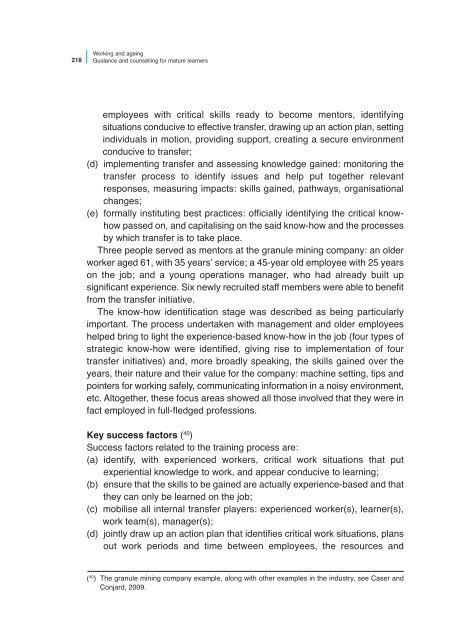Working and ageing - Cedefop - Europa
Working and ageing - Cedefop - Europa
Working and ageing - Cedefop - Europa
You also want an ePaper? Increase the reach of your titles
YUMPU automatically turns print PDFs into web optimized ePapers that Google loves.
218<br />
<strong>Working</strong> <strong>and</strong> <strong>ageing</strong><br />
Guidance <strong>and</strong> counselling for mature learners<br />
employees with critical skills ready to become mentors, identifying<br />
situations conducive to effective transfer, drawing up an action plan, setting<br />
individuals in motion, providing support, creating a secure environment<br />
conducive to transfer;<br />
(d) implementing transfer <strong>and</strong> assessing knowledge gained: monitoring the<br />
transfer process to identify issues <strong>and</strong> help put together relevant<br />
responses, measuring impacts: skills gained, pathways, organisational<br />
changes;<br />
(e) formally instituting best practices: officially identifying the critical knowhow<br />
passed on, <strong>and</strong> capitalising on the said know-how <strong>and</strong> the processes<br />
by which transfer is to take place.<br />
Three people served as mentors at the granule mining company: an older<br />
worker aged 61, with 35 yearsʼ service; a 45-year old employee with 25 years<br />
on the job; <strong>and</strong> a young operations manager, who had already built up<br />
significant experience. Six newly recruited staff members were able to benefit<br />
from the transfer initiative.<br />
The know-how identification stage was described as being particularly<br />
important. The process undertaken with management <strong>and</strong> older employees<br />
helped bring to light the experience-based know-how in the job (four types of<br />
strategic know-how were identified, giving rise to implementation of four<br />
transfer initiatives) <strong>and</strong>, more broadly speaking, the skills gained over the<br />
years, their nature <strong>and</strong> their value for the company: machine setting, tips <strong>and</strong><br />
pointers for working safely, communicating information in a noisy environment,<br />
etc. Altogether, these focus areas showed all those involved that they were in<br />
fact employed in full-fledged professions.<br />
Key success factors ( 40 )<br />
Success factors related to the training process are:<br />
(a) identify, with experienced workers, critical work situations that put<br />
experiential knowledge to work, <strong>and</strong> appear conducive to learning;<br />
(b) ensure that the skills to be gained are actually experience-based <strong>and</strong> that<br />
they can only be learned on the job;<br />
(c) mobilise all internal transfer players: experienced worker(s), learner(s),<br />
work team(s), manager(s);<br />
(d) jointly draw up an action plan that identifies critical work situations, plans<br />
out work periods <strong>and</strong> time between employees, the resources <strong>and</strong><br />
( 40 ) The granule mining company example, along with other examples in the industry, see Caser <strong>and</strong><br />
Conjard, 2009.

















